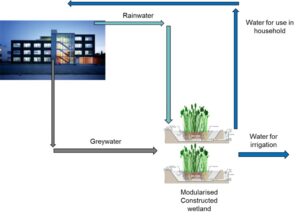The project at a glance
-
Start date:01 Oct 2022
-
Duration in months:24
-
Funding:Administration de la gestion de l’eau
-
Principal Investigator(s):Joachim Hansen
About
In sustainable concepts, greywater has been identified as a potential stream for water reuse in applications such as toilet flushing, washing machines or irrigation of flowers, greens etc. The advantages in reusing grey water for sustainable building are multiple: 1) it replaces potable water use and thus reduces the cost of potable water supply; 2) greywater may contain nutrients beneficial for example for plant growth 3) potential cost reduction for the centralized wastewater treatment plants as treating grey water on site would reduce the flow through the sewer. As main disadvantage, if higher quality is required, treating grey water in a decentralized way is performed mostly in small technical installations such as Membrane-Bio-Reactors (MBR), which lead to high energy consumption, high operation costs and that need regular maintenance from experts. Additionally, reusing treated grey water for bathing or showering could rise the question of risk for human health and social acceptance, thus a risk assessment for greywater reuse would be necessary. In two INTERREG-project (EmiSûre and CoMinGreat), researchers from the Chair for Urban Water Management developed and tested specific Constructed wetlands (a nature-based, vertical flow system with selected plants) as an additional treatment step (after conventional treatment) for Micropollutant elimination from municipal wastewater. Removal rates for Micropollutants as well as ‘classical’ wastewater pollutants (BOD, COD, NH4, P) and germs were excellent. One of the reasons for the very high removal rates is the addition of 15 % active substrate (Activated Biocoal – produced from plants) to the classical substrate (sand). The main idea of the project is to develop and test a modular-designed system for greywater treatment from households – based on Constructed wetlands with the special substrate, as a decentralised solution for the utilisation of treated greywater in sustainable buildings. A pilot plant will be located in Lycée Edward Steichen of Clervaux for the duration of 15 months. The project is funded from the Administration de la gestion de l’eau (Ministère de l’Environnement, du Climat et du Développement durable) particularly interested in saving potable water in line with the scope of the European Commission’s Circular Economy Action Plan as the Luxembourg government’s strategy on Circular Economy.
Organisation and Partners
- Chair for Urban Water Management
- Department of Engineering
- Faculty of Science, Technology and Medicine (FSTM)
- Administration de la gestion de l’eau
Project team
-
Joachim Hansen
-
Dr. Silvia Venditti
Keywords
- Greywater
- Water reuse
- Membrane-bio-Reactors
- Constructed wetlands
- Micropollutant elimincation
- Wastewater
- Sustainable buildings
- AGE
- Circular Economy
